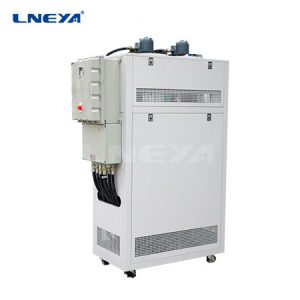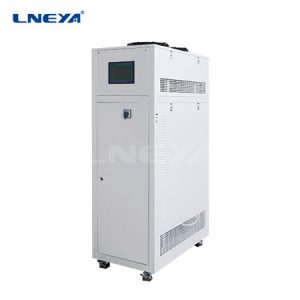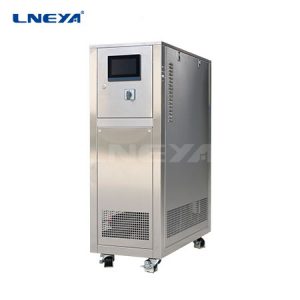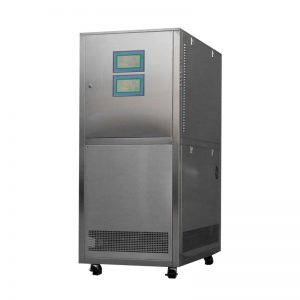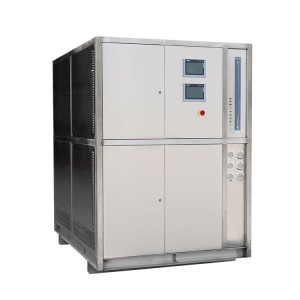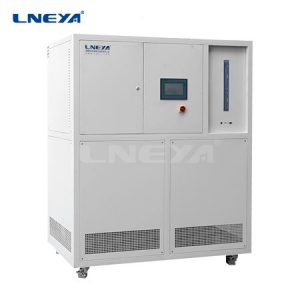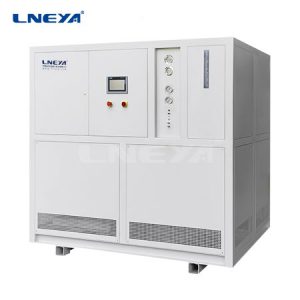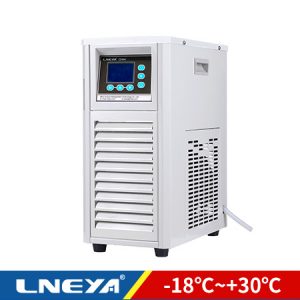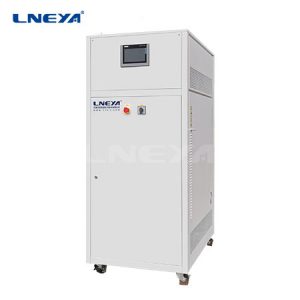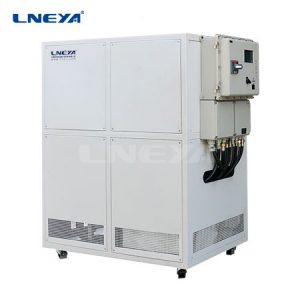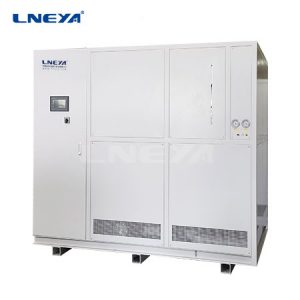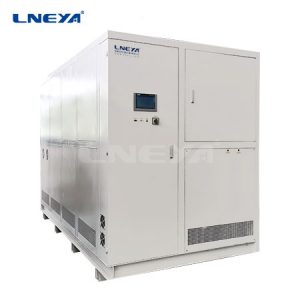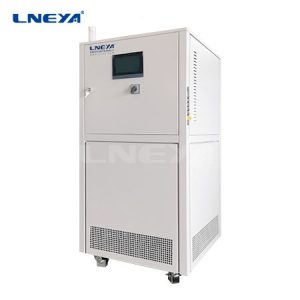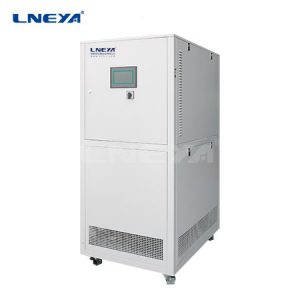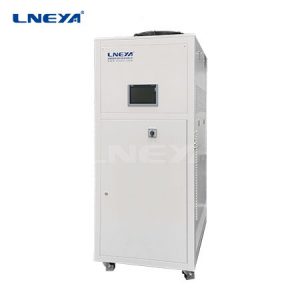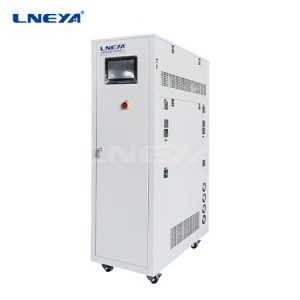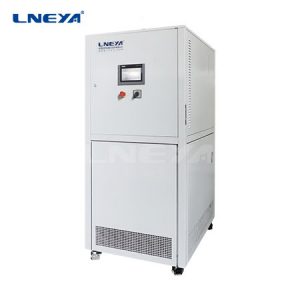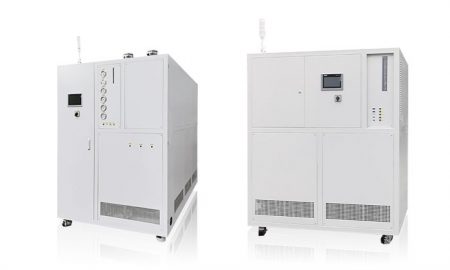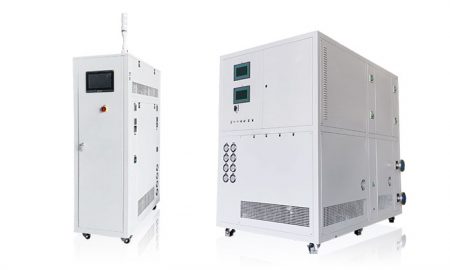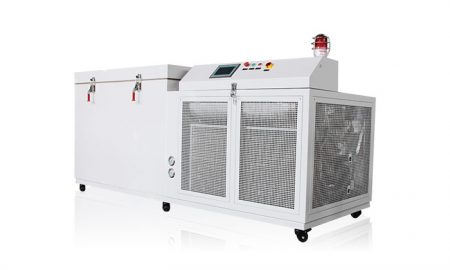Ammonia Refrigeration System Chiller VS Fluorine Refrigeration System Chiller
First, the refrigerant
Ammonia and fluorine (for R22) are both medium-temperature refrigerants. The condensing pressure at room temperature and the cooling capacity per unit volume are not much different. However, in order to increase the cooling capacity, the refrigerant generally needs to be supercooled before throttling. Experiments show that when the condensing temperature tk=30°C and the evaporating temperature to=-15°C, the refrigeration coefficient R22 increases by 0.85% for every 1°C of subcooling, while that of R717 is 0.46%.
Ammonia is poisonous to the human body. Ammonia vapor is colorless and has a strong pungent odor. Once leaked, it will pollute the air, food, and irritate people’s eyes and respiratory organs. Ammonia in contact with the skin can cause “frostbite”. If the volumetric concentration of ammonia in the air reaches 0.5-0.6%, people will be poisoned if they stay in it for half an hour, it will be ignited when the concentration reaches 11-14%, and it will cause an explosion when the concentration reaches 16-25%. The separated free hydrogen accumulates to a certain extent, and it will cause a strong explosion when it encounters air).
The solubility of ammonia in lubricating oil is very small, so there will be oil film on the surface of ammonia refrigerant pipes and heat exchangers, which will affect the heat transfer effect. The specific gravity of ammonia liquid is smaller than that of lubricating oil. In the liquid reservoir and evaporator, the oil will be deposited in the lower part and needs to be released regularly.
When the ammonia pressure is 0 kg, the evaporation pressure is -33.4°C. In order to avoid the refrigeration system working under negative pressure, ammonia is mainly used in large or medium-sized refrigeration systems with an evaporation temperature above -34.4°C.
Freon is a commonly used high, medium and low temperature refrigerant. It is colorless, odorless, non-flammable, non-explosive, and chemically stable. It is basically non-toxic, and can be used in high-temperature, medium-temperature, and low-temperature refrigerators to meet the requirements of different refrigeration temperatures. The minimum evaporation temperature is -120°C. Freon can dissolve lubricating oil to varying degrees, is not easy to form an oil film in the system, and has little effect on heat transfer. At the same time, the design of the Freon chiller also takes into account the replacement of the working fluid, that is, when using the new working fluid, there is no need to modify the system.
Second, the refrigeration system
The characteristics of the ammonia refrigeration compressor itself, when the evaporation temperature is lower than -28°C, two-stage compression is required, and the ammonia chiller needs to provide a pump, a liquid supply system and a complicated oil return mechanism, resulting in a huge system, many auxiliary machines, and pipelines. Complex, with many valves, complex construction and installation procedures, and long construction period. At the same time, there will be hidden dangers of failure. Due to the high toxicity of ammonia, the outward opening door of the machine room is not allowed to be in the same direction as the production plant, and the equipment room of the ammonia refrigeration system should not be arranged in the common building of other plants. Moreover, the noise and vibration of ammonia are large during operation, and the dynamic load generated is large, and the impact on the storage body cannot be ignored. Therefore, the computer room must be set up separately. Moreover, the valves in the ammonia system are all open valves, and a small amount of refrigerant leakage is unavoidable.
The characteristics of Freon determine that the piping of the fluorine system is much simpler than that of the ammonia system. The configuration of the Freon unit is already very complete, and it can be put into operation with a simple connection. Moreover, the fluorine unit is small in size and occupies less land. It does not need to set up a separate machine room, which greatly saves space. The unit has low noise. All valves are fully closed, and there is no leakage of working fluid.
Third, the control system
Ammonia systems cannot be fully automated. Its start, stop and liquid supply adjustment must be done manually, and professionals are required to manage the ammonia machine 24 hours a day, and the protection device is not complete.
The fluorine system can realize fully automatic control without the need for special personnel to take care of it. The protection device is complete, the equipment is equipped with complete protection measures such as voltage protection, temperature protection, current protection, pressure protection, etc., and can realize computer control, and the energy adjustment range is wide.
Fourth, economy
1. Equipment investment comparison
For the same cooling capacity and the same temperature range, the initial investment of different chillers is different. From the perspective of equipment investment for large-scale projects, the overall equipment investment of ammonia refrigeration system is lower than that of Freon.
The ammonia system includes a lot of equipment, mainly including compressors, air coolers, condensers, oil separators, high and low pressure liquid storage barrels, intercoolers, recoolers, ammonia liquid separators, low pressure circulation barrels, and emergency ammonia release devices , air release device, oil collector, ammonia pump and corresponding valves and bypass valves, etc. Ammonia does not corrode steel, but when it contains moisture, it corrodes zinc, copper, bronze and their copper alloys, and only phosphor bronze is not corroded. Generally, seamless steel pipes are used instead of copper and copper alloy materials for ammonia system pipelines. Only parts such as connecting rod bushings and sealing rings are allowed to use high-tin phosphor bronze. Seamless steel pipes are cheaper than copper pipes, but their heat transfer performance is higher than that of copper pipes. The copper pipes are poor.
The main equipment included in fluorine are compressors, air coolers, condensers, oil separators, gas-liquid separators, oil collectors, liquid reservoirs and corresponding valves, etc. Generally, copper pipes are used in fluorine systems, and fluorine systems are bypassed. There are fewer pipes, and the amount of pipes is less than that of the ammonia system. In short, from the perspective of large-scale project equipment investment, the ammonia system is lower than the fluorine system.
2. Installation and construction investment comparison
Due to the complex structure of the ammonia system and the relatively large amount of installation and construction work, the installation and construction investment of the project cannot be ignored. Obviously, the installation and construction investment of the ammonia system is larger than that of the fluorine system.
The ammonia system has a lot of equipment, and the connection of pipelines and bypass valves is complicated. Therefore, the installation and construction must be guided by professionals on site, which requires a lot of manpower and material resources, and the corresponding installation and construction costs are also high. The fluorine equipment is relatively simple, and the system pipeline, bypass valve parts and auxiliary refrigeration equipment are less, so the installation and construction are convenient.
3. Installation and debugging comparison
The ammonia system has a lot of valves, so it is difficult to install and debug. The installation and commissioning personnel must be quite familiar with the ammonia system. During the debugging, carefully adjust each valve until the system runs stably.
The installation and commissioning of the fluorine system is much simpler than that of the ammonia system. As long as the construction personnel have a good understanding of the fluorine system and have certain on-site experience, they can carry out the system commissioning.
4. Comparison of running costs
For a refrigeration device with a large cooling capacity and a long running time throughout the year, it is obvious that the level of operation and management costs is extremely important, even more important than the initial investment. Therefore, we should make a more comprehensive consideration for the actual project, so as to choose the appropriate chiller.
Since the ammonia system is difficult to achieve automatic control, it cannot achieve the best operating condition adjustment, resulting in low refrigeration efficiency and high energy loss.
The fluorine system can fully realize automatic control, including the adjustment of the best operating conditions, the adjustment of the liquid supply of the evaporator, the adjustment of the temperature of the cold room and the evaporation temperature, automatic defrosting, automatic adjustment of the condensing pressure, automatic start and stop of the refrigerator, and energy adjustment , Automatic control of refrigeration auxiliary equipment, etc., which enables the fluorine machine to perform energy regulation and automatic control management of unit start and stop according to actual conditions, which greatly improves refrigeration efficiency and reduces operating costs.
The small temperature difference is also extremely beneficial to reduce the dry consumption of food stored in the warehouse. Because the small temperature difference can make the warehouse obtain a larger relative humidity, which can slow down the degree of heat and mass exchange in the air in the warehouse, thereby reducing the dry consumption of stored food. Ammonia refrigeration system is difficult to realize automatic control, and the warehouse temperature fluctuates greatly, which is easy to cause food dry consumption; while fluorine refrigeration can realize automatic adjustment of refrigeration conditions, and the warehouse temperature is stable, so as to reduce or avoid dry consumption caused by temperature difference .
When the refrigeration system load is unstable, because the fluorine chiller is composed of multiple heads, the unit will automatically start and stop some compressors, cooling water pumps and condensing fans according to the system load. Therefore, when the load of the refrigeration system is unstable, the fluorine system saves electricity compared with the ammonia system. During the operation of the equipment, as the external load changes greatly, although the screw compressor can use the slide valve to adjust its gas delivery volume, the compression work of the gas during adjustment will decrease proportionally with the reduction of the gas delivery volume. , but as a whole compressor, the mechanical loss during operation remains almost unchanged. Therefore, in the same system, multiple screw compressors are used in parallel to replace the operation of a single machine. When adjusting the working conditions, power can be saved, especially in systems with large gas transmission volumes, such as four main engines. In the parallel unit, when the cooling capacity is adjusted to 75%, one main unit can be turned off. At this time, the parallel unit composed of four main units can save energy by 42% compared with a single unit.
The parallel operation of multiple main engines not only brings benefits to the adjustment of working conditions, but also brings a series of other advantages: one is that fewer models can be used to meet the needs of different gas transmission volumes, which is convenient for the production plant and reduces The second is that the hosts can be started one by one during use, which has a small impact on the power grid; the third is that the operating efficiency can be improved. When one of the hosts fails, it can be repaired separately and the system can still maintain operation without affecting production.
5. Refrigeration system consumption comparison
Ammonia system is equipped with many low-temperature equipment in normal temperature environment, mainly including intercooler, recooler, ammonia liquid separator, low-pressure circulation barrel, oil collector, ammonia pump and corresponding valves and bypass valves, liquid supply, Return steam pipeline; only the return steam pipeline and liquid separator are installed in the fluorine system at room temperature, and the fluorine system is completely evaporated, while the ammonia system is incompletely evaporated. The diameter is 4 to 5 times larger, and the volume of the liquid separator is more than 50 times larger than that of the fluorine system.
At the same time, due to the toxicity of ammonia, once it leaks, it will endanger personal safety or damage food. Therefore, the ammonia refrigeration system cannot use direct cooling, only indirect cooling. The indirect cooling is that the air in the cold room does not directly contact the refrigeration Instead of exchanging heat with the refrigerant, it exchanges heat with the brine in the cooling equipment, and then the brine with a certain amount of heat exchanges heat with the refrigerant. Commonly used refrigerants in indirect cooling systems are brine or water. There are many devices in the indirect cooling method, and the cost is high; and the salt water has a corrosive effect on the metal. Due to the secondary heat transfer temperature difference, that is, the refrigerant cools the brine, and the brine cools the air or goods in the warehouse, the heat exchange efficiency is low and the energy loss is large. Decrease the economy, so it can only be used in places where it is not suitable to directly use refrigerants (such as salt water ice making, air conditioning systems) under specific circumstances.
The direct cooling method refers to the cooling method in which the cooling equipment is in the warehouse, and the refrigerant directly absorbs the heat in the warehouse and evaporates in the cooling equipment, thereby reducing the temperature of the warehouse. The characteristics of the direct cooling method are: the refrigerant directly evaporates and absorbs heat in the evaporator, a phase change occurs, the heat transfer temperature difference is only once, and the energy loss is small; compared with the indirect cooling method, the system is simple, the operation and management are convenient, and the investment and operation costs are lower.
6. Comparison of system operation, maintenance and management costs
Different chillers have different conveniences for operation adjustment and daily maintenance. Obviously, it is necessary to choose a refrigeration device that is easy to operate and maintain as much as possible, so as to reduce the personnel and workload of operation, maintenance and management.
Many operations and management of the ammonia system must be done manually. Therefore, professional operators must be on duty 24 hours a day, which increases the workload of on-site operation and maintenance management personnel and the corresponding operation and maintenance management costs.
Since fluorine can realize complete automatic control, it reduces the on-site operation and maintenance management personnel and workload, and can realize 24-hour monitoring without special personnel, and the unit can operate safely and reliably. At the same time, with the improvement of the degree of automatic control, the control precision is improved, the quality of refrigeration products is improved, and the product cost will be controlled and reduced.
In the design of refrigeration equipment, the choice of control mode is an important issue. From the perspective of energy saving, the higher the level of automatic control, the higher the level of energy saving and consumption reduction of refrigeration equipment. Compared with manual operation, the maximum power saving effect of automatic control is 44%. At the same time, with the improvement of the degree of automatic control, the control precision is improved, the quality of refrigeration products is improved, and the product cost is reduced. On the other hand, automatic control can obviously prevent accidents and ensure the personal safety of operators. Automatic control greatly reduces the labor intensity and workload of operation and adjustment, and can reduce operators. Therefore, a higher degree of automatic control can be selected when conditions permit.
7. Maintenance cost comparison
For large-scale projects, equipment maintenance costs are also a non-negligible part.
The ammonia system has more valves and auxiliary equipment, and more leak points, which will undoubtedly increase the maintenance and management costs of the system. The maintenance cycle of ammonia system equipment is one year, and the overhaul cycle is generally three years (to repair the entire equipment). The workload and time for equipment overhaul and maintenance are relatively long. Such a long maintenance period will increase expenditure on the one hand, and may affect normal production on the other hand.
The service life of the fluorine system compressor is generally 10-15 years, and there are no wearing parts. During the use period, except for daily maintenance, no major maintenance is required, which saves a lot of maintenance and management costs.
8. Comparison of operational reliability
Depending on the refrigeration object, the reliability requirements for the refrigeration process are also different. For important occasions where the cooling process is not allowed to be interrupted, it is obvious that a chiller with high reliability should be selected to prevent major economic losses due to maintenance and other reasons.
The ammonia system has a lot of auxiliary equipment and complicated pipelines. Therefore, there are many vulnerable parts. Once a component fails, it will affect the cooling effect of the whole ammonia system, and even lead to the paralysis of the whole refrigeration system in serious cases.
Compared with the ammonia system, the fluorine system is much simpler and has fewer wearing parts. Therefore, the fluorine machine parallel unit operates reliably. Even if a component or a compressor fails, it will not affect the entire refrigeration system. The maintenance period shorter.
9. Investment comparison of affiliated projects
Power distribution requirements: Ammonia compressors have large installed power, large start-up current, and high power distribution requirements; fluorine compressors have small installed power, small start-up current, and low power distribution requirements.
Refrigeration machine room configuration: Because ammonia is a highly toxic, flammable, and explosive working medium, the shockproof level of the ammonia machine room is 10; there is no standard requirement for the fluorine machine room, and it can be used indoors or outdoors. Due to the large and numerous auxiliary equipment of the ammonia system, the equipment covers an area 5 to 10 times larger than that of the fluorine machine.
From the comparison of many actual projects, the overall equipment investment of ammonia refrigeration system is slightly lower than that of Freon in terms of equipment investment for large-scale projects. However, from the perspective of investment in ancillary facilities and long-term use, maintenance, and management costs, the investment in ammonia refrigeration systems is not lower than that in Freon refrigeration systems. For small and medium-sized projects, the investment of ammonia system is obviously higher than that of Freon system.
10. Economic Analysis of Ammonia Refrigeration System and Freon Refrigeration System
Ammonia refrigeration system is the refrigerant with the longest history. It has good thermal properties, moderate high and low pressure in the cycle process, large cooling capacity per unit volume and high refrigeration coefficient. It has been widely used in my country. However, ammonia is explosive, toxic, and has a strong pungent smell. The equipment is large in size, with many auxiliary equipment, complex systems, difficult operation and maintenance, and difficult to realize automatic operation control. Therefore, it is gradually replaced by Freon refrigeration systems. The following is a comparison of the technical indicators of the ammonia refrigeration system and the Freon refrigeration system:
1) Operating cost: power consumption. In order to meet the refrigeration design requirements of this project, Freon refrigeration system (excluding air cooler) is adopted, and its power is 15% lower than that of the refrigeration system using ammonia working fluid.
2) Operation and management costs: the ammonia refrigeration system consists of a refrigeration unit, ammonia oil separator, high-pressure liquid receiver, condenser, low-pressure circulation liquid storage barrel, oil collector, ammonia pump and air cooler, etc. It is very difficult and requires a high professional level of operators. At the same time, because it is difficult to realize automation, the system requires operators to be on duty 24 hours a day for operation and management. According to the technology of 3 people per shift, about 12 operators are required. The freon refrigeration system has simple pipelines, fewer valves and other operations, and a high degree of automation. Only 2 to 3 people can be operated and managed, and labor costs can be saved by about 200,000 yuan per year.
3) Maintenance cost: The ammonia refrigeration system needs to repair and replace the parts of the unit every 3000 hours (about 3 months) of operation on average, and replace a lot of lubricating oil at the same time: although the price of ammonia refrigerant is cheap, but because the ammonia refrigeration compressor is often open , easy to leak, need to add a lot of refrigerant every year.
4) Initial investment Civil construction investment: The ammonia refrigeration system has many accessories, and it is necessary to set up machine rooms and equipment rooms separately, which occupy a large area. The installed capacity of the ammonia refrigeration system will increase by about 15%.
5) other
The Freon refrigeration system adopts parallel units, and the power of a single compressor is small. When the outdoor temperature is low in winter, the refrigeration unit can automatically perform multi-level energy adjustment. When the load is large, multiple compressors operate at the same time. When the load is small in winter, some compressors may be running, and the energy-saving effect is very obvious: although the ammonia refrigeration compressor can also perform energy adjustment (manually), but the single-unit power of the compressor is relatively large, the energy-saving effect is not obvious.
Ammonia and lubricating oil are immiscible. After the ammonia system has been running for a period of time, a large amount of oil will be deposited on the bottom of heat exchange equipment such as condensers and air coolers, which will reduce the thermal efficiency of the heat exchanger. Therefore, regular manual cleaning is required.
When the concentration of ammonia in the air reaches a certain value, it is easy to explode in case of open fire, so the machine room is required to have good ventilation. In this way, the machine room and equipment room can only be set in a corner of the cold storage or separately, resulting in long system pipelines and high cooling loss. Big.
Due to the high toxicity of ammonia, once it leaks, especially in the warehouse, it will pollute the items in the warehouse and affect the product quality.
Due to the low degree of automation of the ammonia refrigeration system, the reliability and economy of the system operation are basically determined by the personnel, and the quality of the items stored in the warehouse is also determined by the operator, which requires the operator to be trained to master the operation skills; and Freon The refrigeration system operates automatically, and the reliability of the system is basically not affected by human factors.
To sum up, although the one-time investment of the ammonia refrigeration system is 20% cheaper than that of the Freon system. But it is 10% more than the Freon system every year, and it will be higher than the Freon system in only 3 to 4 years. Therefore, it is more economical to use Freon system in this project.
Wir sind ein professioneller Hersteller von Temperaturkontrollgeräten und unterstützen kundenspezifische Dienstleistungen, bitte uns konsultieren für Details!
 LNEYA
LNEYA
 简体中文
简体中文











































































